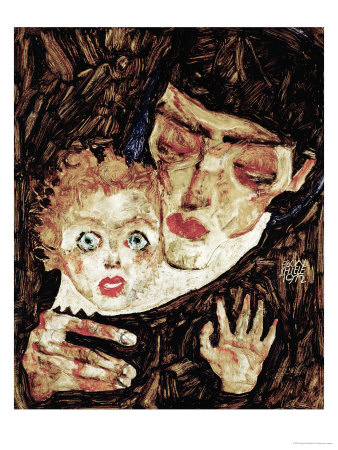Dead Mother I, 1910
This is Dead Mother I, from Schiele's dead mother series. Working Parallel to Freud, many artists in this time period were heavily influenced by Psychoanalysis, and the psychological nature of Schiele's work is undeniable. In psychoanalysis, there is a phenomenon in which patients raised by borderline personality mothers believe that their mothers are death-giving, rather than life giving. Note the corpse-like qualities and pallor of the mother in Dead Mother, who is in this case the one dying (or dead) and the child the healthy one (giving death). Nevertheless, this is consistent with the phenomenon, as role-reversal in mental representations of relationships by patients (e.g. murderer becoming the murdered) is common. (Gourguechon)
Mother and Child, 1912
Schiele's own relationship with his mother was a difficult one, as he resented her for-- as he saw it-- not sufficiently mourning the early death of his syphilitic father with whom he felt he had a special relationship. As well, he felt she did not give him the attention he deserved:
“My mother is a very strange woman ... She doesn't understand me in the least and doesn't love me much either. If she had either love or understanding she would be prepared to make sacrifices.”
(Lucie-Smith)
It is reasonable to view the Dead Mother series as an expression of Schiele's mental image of a death-giving mother.
Death and the Woman, 1915
Schiele frequently mixed themes of eroticism and death or decay, and in the case of Death and the Woman (1915), with him as the cloaked figure of death. The girl, his then-girlfriend Wally (with whom he would break up shortly after completion of the painting) appears sickly and emaciated. The sparing use of color and greenish-brown tones seen here and in many of his works speaks to Schiele's preoccupation with death and decomposition, perhaps both emotional as well as physical.
Close to when he would also die, Schiele did a series of drawings of his former mentor Gustav Klimt as Klimt lay on his deathbed. Schiele's wife Edith died a few months later of the Spanish Flu, and he drew a portrait of her as she lay dead. Schiele also caught the Spanish Flu, and died 3 days after Edith. These portraits are among the final expressions of the artist's underlying desire to capture death in his work.




